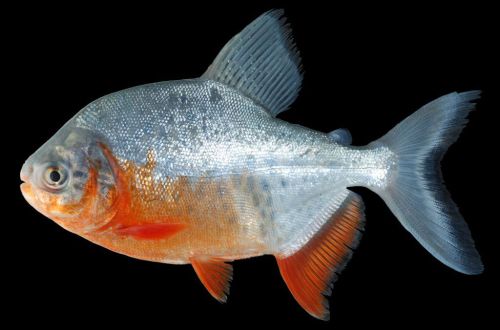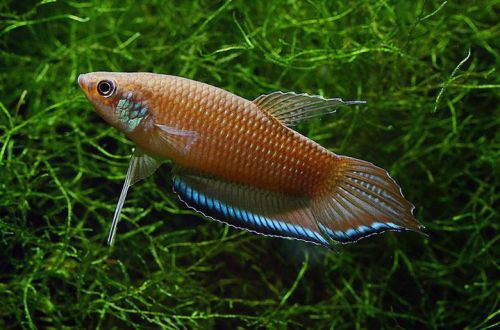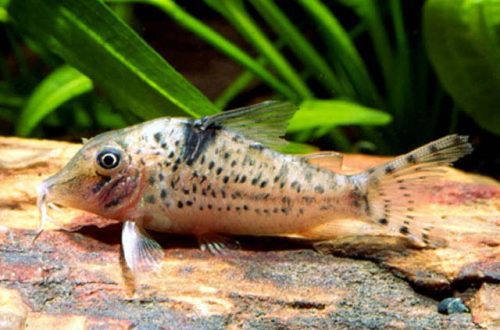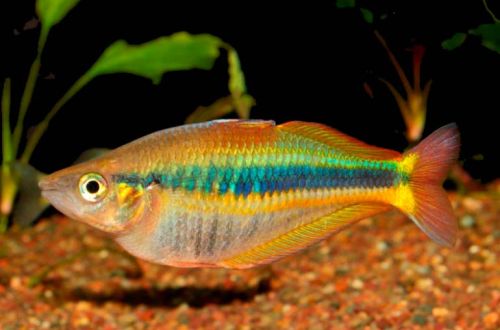
red-bellied pacu
The red-bellied Pacu, scientific name Piaractus brachypomus, belongs to the subfamily Serrasalminae. This fish is rarely considered a resident of the home aquarium, mainly because of its size and rather nondescript coloration. But not infrequently purchased by individual (wealthy) enthusiasts as a safe alternative to Piranha, which Pacu is very similar to.
Banned for sale in many tropical and subtropical countries. The reason for this is the aquarists themselves, who release it into natural reservoirs when it gets bored. Fish successfully take root and disturb the ecological balance, displacing native species.

Contents
Habitat
It comes from South America from the vast expanse of the Amazon basin. The distribution area covers the territories of Colombia, Venezuela, Peru, Bolivia and Brazil. This species was brought to Asia, where it successfully took root as a commercial fish.
The natural habitat is river channels and floodplains among the rainforest, which is regularly flooded during the rainy season. Prefers shallow areas of slow flowing rivers with floating or low overhanging vegetation. Young individuals spend the first months of their lives in floodplains, where there is an abundance of food and a minimum of predators.
Brief information:
- The volume of the aquarium – from 1000 liters.
- Temperature – 23-28°C
- Value pH — 4.8–7.5
- Water hardness – soft (1-15 dGH)
- Substrate type – sandy, soft
- Lighting – subdued or moderate
- Brackish water – no
- Water movement – light or moderate
- The size of the fish is up to 60 cm.
- Food – any, mostly vegetable
- Temperament – peaceful
- Content single or in a group
Description
The largest recorded length of an adult fish was 88 cm. But usually fish do not exceed 60 cm. Sexual dimorphism is weakly expressed, it is problematic to distinguish a male from a female.
This species is often sold under the name Vegetarian piranha, for its resemblance to this formidable predator of the Amazon. The red-bellied Pacu really does look like a piranha. It has a laterally flattened body and relatively small fins. The coloration is dark grey. In young fish, the abdomen is red. As they grow older, the red hues are lost.
Food
It feeds on almost everything that can fit in the mouth of this fish: fruits, nuts, fruits, seeds, insects and their larvae, crustaceans, worms, small fish. However, the basis of the diet is still vegetable. In a home aquarium, for example, you can serve pieces of bananas, apples, peaches, carrots, zucchini, peas, grapes.
Maintenance and care, arrangement of the aquarium
The size of the fish implies a large aquarium with a volume of thousands of liters. When it comes to keeping a Red Belly Pacu, equipment is more important than decoration. The fish can also live in a completely empty tank with a couple of large stones as decoration. Plants are not needed as they will be eaten.
Maintaining a stable biological system in aquariums with large fish requires serious costs, knowledge and experience, so the selection of equipment, installation of the aquarium and its subsequent maintenance should be done by professionals. Thus, the details of the content of this species are beyond the scope of this article.
Behavior compatibility
Peaceful, calm and even shy fish. Compatible with many species, except for very small ones. Adult large individuals are able to get along with aggressive and predatory fish. Can live alone or in a group.
Breeding / breeding
Successful cases of breeding in aquariums have not been recorded. Offspring are engaged in large fish farms in South America and the Far East using hormones.
Fish diseases
Hardy and unpretentious fish. Health problems arise only when kept in adverse conditions and poor-quality nutrition. Read more about symptoms and treatments in the Aquarium Fish Diseases section.





